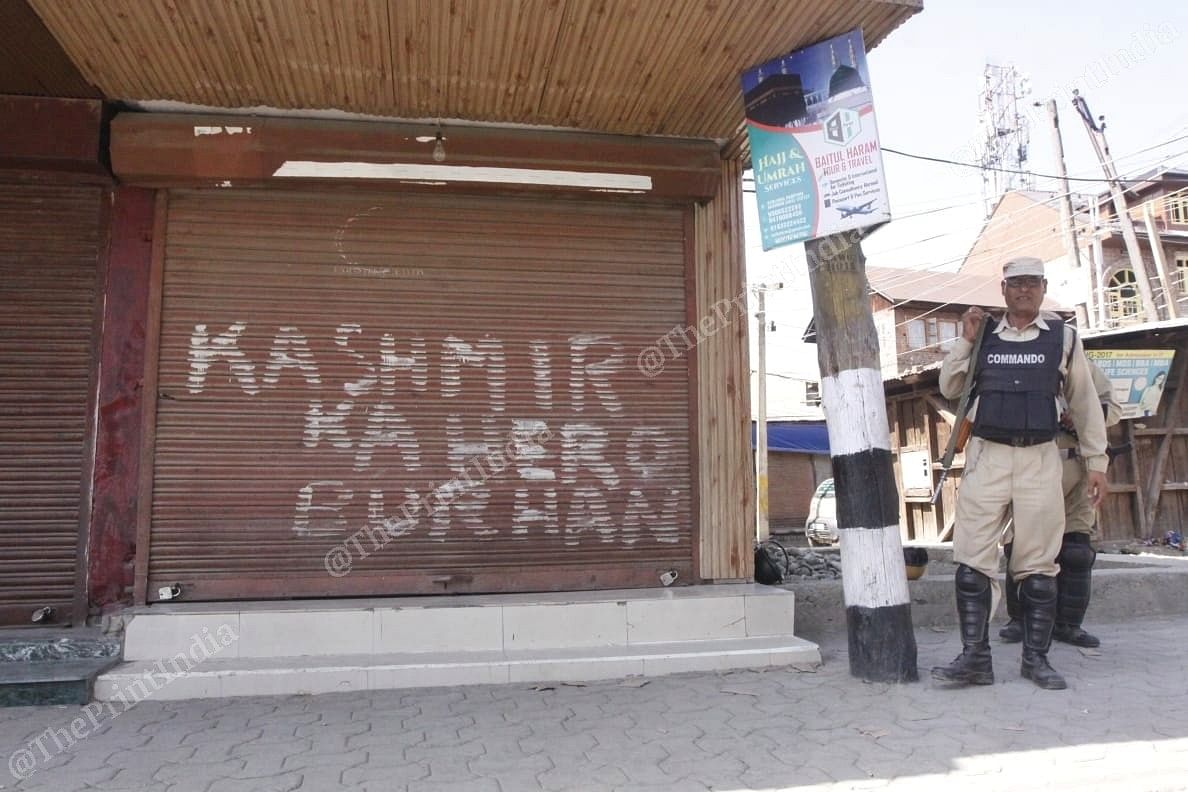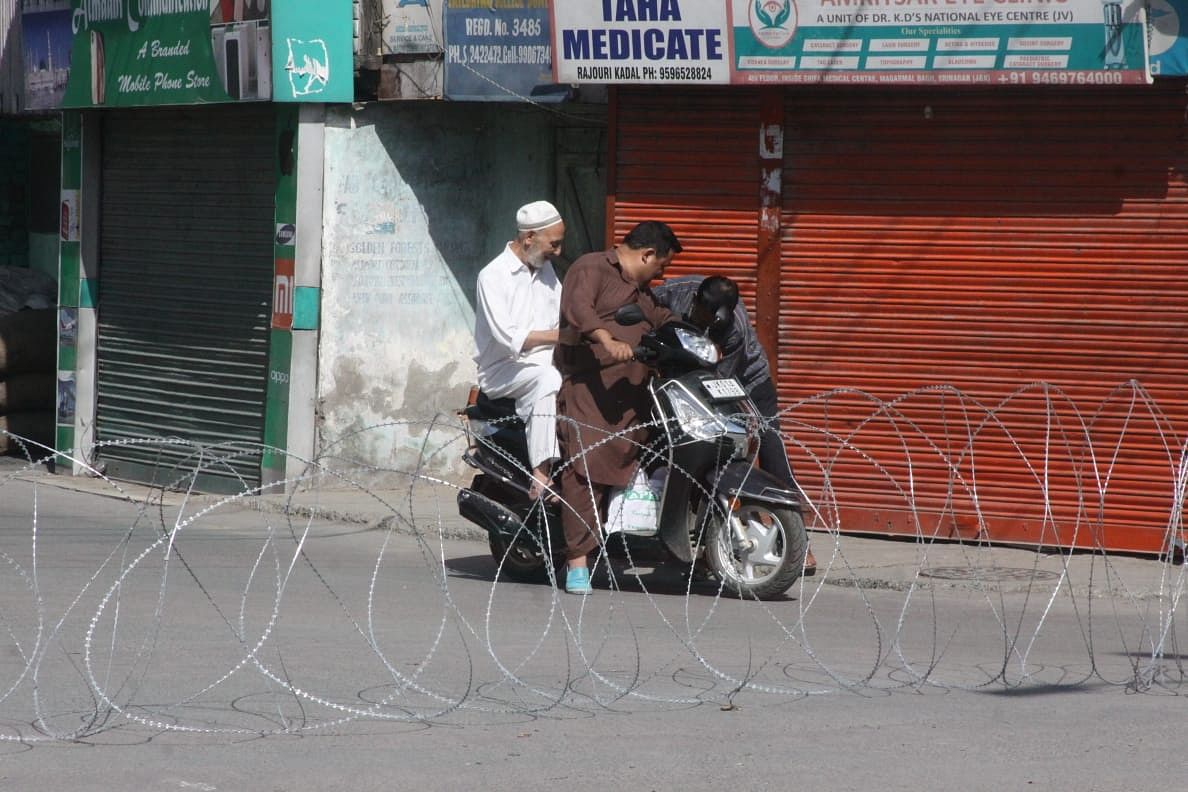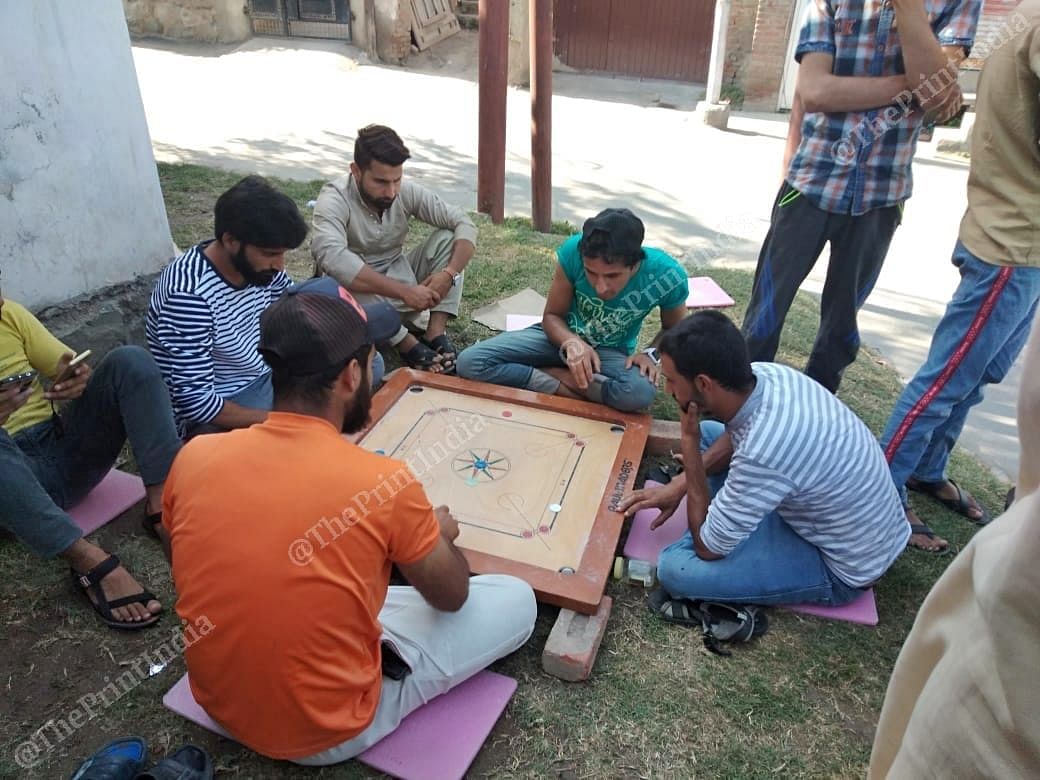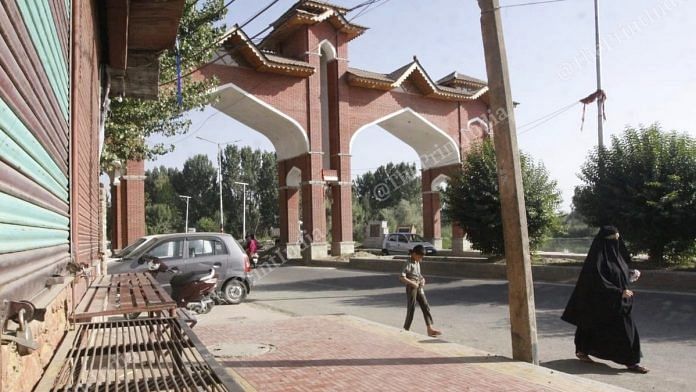Srinagar: Pass through the imposing red-brick Sheher-e-Khas gate in the heart of Srinagar and the graffiti — painted in bold red and black — on downed shutters strikes you at once.
“Go India Go back”, “Azad Kashmir”, “Burhan Town”, “We want Freedom”, “Save Kashmir” are some of the messages that have been painted on almost every shop, wall and corner. Welcome to downtown Srinagar.
Divided into over 70 localities, the downtown area houses the landmark Jama Masjid and several markets, besides factories and wholesale dealers of dry fruits, foodgrain, shawls, carpets, gold, papier-mache, and copper, among other things. It is the most populated area of the city, housing 60 per cent of its people.

The world over, “downtown” is the main commercial area of a city, bustling with activity, even through the night. But not in Kashmir.
Here, with the slightest “provocation” from the government or a strike call from separatists, commercial activity comes to a standstill for the cause of “azad Kashmir” and the area erupts in protest. So much so, that Hurriyat separatists are known to rely on downtown for the success of their bandh calls.
With sporadic incidents of stone-pelting reported every now and then, the area has become a “no-go zone” for outsiders visiting Kashmir, especially during sensitive times like the Valley is witnessing right now, in the aftermath of the scrapping of Article 370 and 35A.
Downed shutters, deserted roads, passages blocked with concertina wires, a visibly stronger military presence than in other areas, and stones strewn around almost every 100 metres, are common sights. It was here, in Soura, that the first protest against the Article 370 move was reported on 8 August, the first Friday after the decision.
It’s been 50 days since Jammu & Kashmir was stripped of its special status, and the strict restrictions on communication imposed at the time remain in place in the Valley.
While uptown Srinagar — home to all the government offices, including the secretariat and the high court, a few markets, a small shopping complex, and some schools — is limping back to normalcy, downtown remains tense.
Also Read: I went to meet pellet gun victims in Soura, the new epicentre of Kashmir’s anger
‘The oldest part of the city’
An official from the Jammu & Kashmir town planning department told ThePrint that downtown was considered to be the main city, while other areas, including Raj Bagh and Jawahar Bagh, were “outskirts” .
Some of downtown’s well-known localities include Rainawari, Nowhatta (where Jama Masjid is located), Maharajgunj, Khanyar, Anchar, Soura, Hawal and Safakadal.

Most of Srinagar’s educational institutions, including the Women’s College, Islamic University of Science & Technology, and Gandhi Memorial College, fall in the downtown area. As do the two biggest government hospitals, Sher-i-Kashmir Institute of Medical Sciences (SKIIMS) and Shri Maharaja Hari Singh (SMHS) Hospital.
The area also houses the most number of shrines and mosques — the biggest being the Jama Masjid, from where the moderate separatist Mirwaiz Umar Farooq (currently under house arrest) gave his sermons.
“It is the oldest part of the city. The uptown came up much later,” the aforementioned official said. “The downtown area is the lifeline of the state as it houses most factories and units, but it is often marred by clashes. Either there is a hartal call from separatists, or people themselves protest against the government,” the official added.
A local shopkeeper said the current image of downtown was the handiwork of police and politicians.
“These cops and politicians have just maligned this area to further alienate us all,” the shopkeeper added. “Downtown is the education hub of Kashmir. It is not some backward area. All the old prestigious educational institutions, including the Women’s College, are here.
“The administration here has painted the wrong picture… that all the stone-pelters stay here and it is always on the boil. Yes, we will protest if we are not heard or if we are exploited, but otherwise this is no dungeon where criminals stay,” the shopkeeper added. “Move around and you will see for yourself.”
Also Read: Classrooms empty, Srinagar’s private schools bring lessons home via video CDs
The ‘hotbed’
Be it 2008 (when Kashmir witnessed protests over the killing of Sheikh Abdul Aziz, a Kashmiri separatist), 2010 (protest over killing of three Kashmiris in a “staged” encounter), 2016 (encounter of Hizbul Mujahideen commander Burhan Wani) or 2019, downtown has accounted for the highest number of clashes, arrests and curfews in the Valley.
“Nowhatta… has been the hotbed for stone-pelting. Here, over 2,500 people can congregate to offer prayers at the same time,” said a second shopkeeper. “So, the moment youngsters used to come out after prayers, they would start throwing stones at the forces. They then had to be dispersed.”
Jama Masjid has been locked since the scrapping of Article 370 to avoid the kind of large congregations it is known to draw, especially for Friday prayers.
“Whether it is Nowhatta or Rainawari, these youngsters come together, collect stones and attack police and the forces whenever we try to enter for patrols or a search operation,” said a Jammu & Kashmir Police officer. “It has left many of our men injured.
“Also, while the hartal is on, these men do not even let other local residents, who wish to follow their daily routine, work,” the officer added. “They throw stones at cabs being driven by Kashmiris to scare them.”
The narrative, however, undergoes a complete shift when questions are posed to some local residents, who claim security personnel extort money from them and assault them.
“Are we senile to be throwing stones just like that?” a youngster said. “These policemen extort money from us. They enter our houses on the pretext of a search operation and then ask for money. They threaten to round up the young boys in a crackdown if we do not pay up. Why would we let them enter here?” he added. “If they have pellets, we have stones,” he said.
A deepening sense of alienation
Downtown residents feel segregated and neglected by the administration, saying this further fuelled their sense of alienation.
“Since the area has been involved in anti-government protests, all we see here is search operations, Army and more Army,” said a 36-year-old resident of Rainawari. “Nothing else. No drinking water, no sanitation, no electricity. Just the Army.
“Since we have been labelled stone-pelters, there is now a mindset,” the Rainawari resident added. “If police have raided the area, we must be in the wrong. No one even questions police for the atrocities they commit, for blatantly misusing their power and ammunition. They (government) think pellets are what we deserve.”
Given its image, real estate prices in the area have hit a low. Many residents have moved uptown, and several youngsters travel to different cities for studies.
“The literacy rate in this area is very poor. The youngsters sit out all day, either playing carrom or holding meetings to go about some mischief (stone-pelting),” an official with the J&K government’s administrative department said.

“Many business families who could not afford to incur losses due to frequent bandhs in the area, moved to Jawahar Bagh and Hyderpora,” the official added.
Traders from major markets like Nalahmaar, Gada Bazar, Zaina Kadal, Malaratha, Gada Kocha, Bohri Kadal, suffer massive losses each time there is a hartal, including the current one, which has lasted for almost two months.
“We have suffered losses, but then we never think of moving out as it is our people who are suffering,” a member of a local traders’ association said. “We cannot be that selfish to leave them alone.”
The spirit of “Kashmiriyat”, after all, is the one thing people here hold dear.
“Here, the people believe in unity. You will find a strong community feeling everywhere,” said a 79-year-old shopkeeper. “One call and everyone will listen. These people (government) think they are suppressing us by deploying so many security personnel around, but they do not realise that they are making our resolve for azadi stronger,” the shopkeeper added.
Also Read: J&K has 2 sets of cellphone numbers — those on ‘white list’ work, ones on ‘black list’ don’t




The night might be dark, the sun will rise. Kashmir will have it’s say. The occupiers will return and little kids of downtown will smile. Love and respect to the resilient people of downtown, of my motherland
As a Kashmiri I am angry with this article, don’t blame us as the author tries to do for our economic woes.
The root cause of the problem is that India is the colonial oppressor.
The British media of the 1940s said look at the hartals, called by Gandhi, look at their economic losses they incur these Indians, look at their colleges closed. It’s their own fault they do this to themselves.
The author here tried to show our suffering is self inflicted.
I refer him to the freedom struggle of his parents and grandparents generation,
against the British.
Don’t blame the victims blame the jackboots of the oppressor.
Admire us for our bravery and sacrifice, just as you keep eulogising your freedom own fighters who fought British oppression.